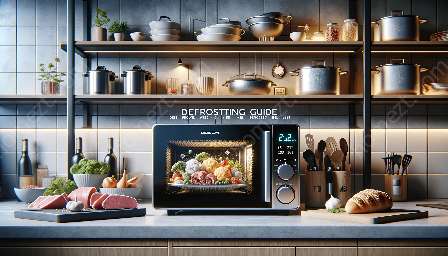Defrosting food in a microwave oven can be a quick and convenient way to prepare a meal. However, there are important factors to consider to ensure that the food is safely defrosted while maintaining its quality. In this comprehensive guide, we will explore the best practices for defrosting in a microwave oven, including tips, safety precautions, and common mistakes to avoid.
Understanding Defrosting in a Microwave Oven
Microwave ovens use electromagnetic radiation to heat and cook food. When used for defrosting, the microwave's low-power setting allows the food to thaw quickly and evenly. It's important to understand that the defrosting process in a microwave is different from conventional methods and requires attention to prevent partial cooking of the food.
Choosing the Right Setting
Most microwave ovens have a defrost setting or allow you to input the weight and type of food for customized defrosting. It's crucial to select the appropriate setting based on the type and quantity of the food to prevent overcooking or under-thawing.
Best Practices for Defrosting
When defrosting in a microwave, follow these best practices to ensure safe and efficient results:
- Use Microwave-Safe Containers: Transfer the food to a microwave-safe container before defrosting to prevent contamination and ensure even thawing.
- Rotate and Stir: To promote even defrosting, rotate and stir the food at regular intervals during the process.
- Monitor Progress: Check the food frequently to prevent over-thawing or partial cooking. Larger items may require more time and attention.
- Refrigerate Promptly: Once the food is partially defrosted, it's essential to cook or refrigerate it immediately to minimize the risk of bacterial growth.
Safety Precautions for Microwave Defrosting
While using a microwave oven for defrosting is convenient, it's important to observe the following safety precautions:
- Use the Correct Power Level: Select the appropriate power level to ensure that the food thaws evenly without cooking.
- Follow Recommended Times: Consult the microwave oven's manual or reputable sources for recommended defrosting times based on the type of food.
- Check Temperature: Use a food thermometer to verify that the product has reached a safe temperature before cooking.
- Avoid Partial Cooking: Be vigilant to prevent the food from starting to cook during the defrosting process. Interrupt the cycle if any signs of cooking are observed.
Common Mistakes to Avoid
When defrosting in a microwave oven, it's crucial to avoid these common mistakes that can compromise the quality and safety of the food:
- Defrosting in Packaging: Do not defrost food in its original packaging, especially if it's not microwave-safe. Transfer the food to a suitable container before defrosting.
- Ignoring Recommended Settings: Always follow the recommended settings based on the food type and weight to prevent uneven thawing or partial cooking.
- Overlooking Standing Time: After the defrosting cycle is complete, allow the food to stand for a few minutes to ensure that the temperature equalizes and any remaining ice crystals melt.
Conclusion
Proper defrosting in a microwave oven is a convenient way to prepare ingredients for cooking while saving time. By following the best practices, safety precautions, and avoiding common mistakes, you can ensure that your food is safely and evenly defrosted, ready for the next step in your culinary creation.





















